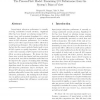Free Online Productivity Tools
i2Speak
i2Symbol
i2OCR
iTex2Img
iWeb2Print
iWeb2Shot
i2Type
iPdf2Split
iPdf2Merge
i2Bopomofo
i2Arabic
i2Style
i2Image
i2PDF
iLatex2Rtf
Sci2ools
SIGMETRICS
1993
ACM
1993
ACM
The Process-Flow Model: Examining I/O Performance from the System's Point of View
Input/output subsystem performance is currently receiving considerable research attention. Signi cant e ort has been focused on reducing average I/O response times and increasing throughput for a given workload. This work has resulted in tremendous advances in I/O subsystem performance. It is unclear, however, how these improvements will be re ected in overall system performance. The central problem lies in the fact that the current method of study tends to treat all I/O requests as equally important. We introduce a three class taxonomy of I/O requests based on their e ects on system performance. We denote the three classes time-critical, time-limited, and time-noncritical. A system-level, trace-driven simulation model has been developed for the purpose of studying disk scheduling algorithms. By incorporating knowledge of I/O classes, algorithms tuned for system performance rather than I/O subsystem performance may be developed. Traditional I/O subsystem simulators would rate such alg...
| Added | 10 Aug 2010 |
| Updated | 10 Aug 2010 |
| Type | Conference |
| Year | 1993 |
| Where | SIGMETRICS |
| Authors | Gregory R. Ganger, Yale N. Patt |
Comments (0)

